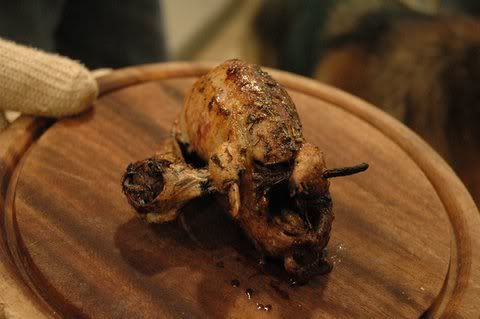In case you shoot one, here is a recipe for you-
Recipe
The roasted Bécasse "A ma manière !"
Also named "Bécasse aux bowels" by Kirk Hogan
Firstly, "wait" your woodcock. Hang the bird by the neck in full feathers outside the house but in a dry place. If the winter is mild, leave it for around five days. If the weather is very cold, wait for a week or ten days. When the bird is ripe, get rid of the feathers, keep only the painter's feather -La plume du peintre- (1). And start a the same time two "culinary works" as:
1/ La Bécasse (the woodcock) & 2/ La Rôtie (the toast).
La Bécasse.
Make a delicate incision on belly and put all the "insides", on a cutting matt.
Take the bird in your left hand and the head (still attached but eyes ripped off), in the right hand. Push firmly the bill through the legs at level of the knees. This way the bird is presented, "à la mode classique".
Melt some butter in your fingers and proceed a massage of bird's body, then season the skin with salt and pepper .
The bird is (or birds are) then placed on a steel dish and put inside hell fire oven, accompanied by one or two garlic cloves "en chemise" (keeping the outer skin).
La Rôtie (the toast) (2)
Chopp the "insides" with a good knife, (get rid of the gizzard, which looks like a little hard ball). Put everything in a small casserole with a "nut" of butter, on not too warm a fire.
You will quickly see a smooth transformation (difficult to explain) of color and aspect. When it's all "transformed" like after 3 or 4 minutes, take some wheat flour with your fingers and pour in rain on this. Mix thoroughly and wait another minute.
Add a drop of Armagnac, and heat a bit more. Prepare a lighter, when you see its OK, Fire ! Whaoum !!! flambé the Armagnac ... take away from fire, mix again thoroughly adding very little of salt and pepper. Leave it apart, it should look like a brown paste.
The toast themselves are pieces of bread that you should have left on air since yesterday. Fresh bread doesn't work for this.
Heat some oil in a pan and roast (or better said, fry) the bred slices on both sides. Blond is the colour to obtain and the surface of the bread must be crusty. French baguette bread is the best, but white bread US or UK style should work also. (I guess a good baker's loaf will be better than industrial plastic bread).
If you take a French baguette as a measure, you should get two toasts (cut into slices shape) per bird. So if it's the big square Anglo Saxon bred, one toast cut in two triangles will do.
When these are blond (this operation can be done as # 1st, any time before), place them on a grill or on absorbing paper to get rid of some frying fat.
Take your casserole with the insides and Armagnac preparation and spread over the toasts.
Back to the Bird.
It must be "golden brown", like any roast chicken or partridge. It must be well cooked everywhere but absolutely not dry. It's an art ! Also it must have produced a nice gravy singing (but not burning) in the steel dish.
Garlic must offer no resistance to a fork. If it is still hard, it usually means that birds are not cooked enough. It mostly depends on the number of birds. 8 birds will need more time than 6, needing also more time than 1 or 2.
Usually with 30 minutes it is all OK.
Now you think your birds are "to the point", turn the oven and follow me:
1/ Bend birds on the steel dish to get all the gravy that is inside.
2/ Place the birds waiting somewhere where they won't get cold.
3/ Place your toasts inside the still hot oven.
4/ Put your steel dish on a fire. Scratch the bottom with a fork. Mash with the fork one of the garlic cloves. Add a drop of the red wine you will drink at the table, plus a very small wee of Armagnac and a few drops (5 or 6) of lemon juice. Add a little of thyme, correct the salt and pepper, let it boil once - the result must be brown - and put in a warm saucepan.
Put one bird on each (hot) plate with the two toasts around but the gravy apart. Just use the gravy gradually, toasts are not gravy sponges !
No vegetable is expected at this moment of the meal. A salad as a follower should be enough for today.
Remember that Armagnac and wine must be used with great discretion and should not mask in any way the taste of the gravy or be too present on the toast. (Neither should the lemon, only the cook must know that this light acid touch comes from lemon. If someone recognizes lemon... you'll just do better the next time).
Eat comme des cochons... (like pigs), there must be no leftover of flesh on any bone.
I finally cant resist paraphrasing Alexandre Dumas at the end of his recipe for snipe called: "Salmis des moines Bernardins" in the Almanach des Gourmands of the year 1806
"You must pay great attention to giving forks to the guests in the fear they could devourish their fingers if those had touched the sauce" !
And as we speak of literature, you can also end up with the tradition of the "Dîner des bécasses du baron des Ravauds" of Guy de Maupassant in his Contes de la Bécasse.
Take an empty bottle of good wine, replace the cork on top and push a pin on top of the cork. Set a woodcock head on the pin, place it all at the center of the table. Ask an innocent hand to push the bill and make the head turn -its a sort of woodcock roulette. When the head stops, the bill should be pointing one of the guests. This one has the privilege to eat all the heads but must tell a good long story to the others while they light a cigar and sip their Brandy warmed up by flames of the fireplace. (If you want the story to be good, watch out the number of bottles you serve, the right point is between generously and too much).
Amitiés en Saint-Hubert / Nick
(1) La plume du peintre
The painter's feather, is an elegant small sharp feather found at each elbow and there is only one on each wing. It was used by naturalist painters for its sharp precise point. It is the small feather crossing the bell on the CNB's logo, but it is much smaller than the bell. Only like 2 or 3 centimeters long maximum. Some hunters place it inside their hat's belt as a trophy to carry all day. Others keep them in a small box for the sad moment when their good woodcock dog will leave this world. A framed picture is realized with all the pairs of feathers displayed nicely as little trophies recalling each bird pointed and bagged during the career of the good dog.
(2) Note for people who are learning French...
The word "rôtie" sounds more like roasted piece of meat, but the ancient translation for toast was "rôtie". Now we use the English word "toast" for breakfast or tea time but "rôtie" or "croûtons" in this case. However, "rôtie" is more proper. A roast beef would spell "rôti" without "e" at the end.
*
In search of woodcocks, on the "Risoux",
in the Mounts of Jura near the border with Switzerland.
Other page - Back to top

 The one I saw was really cool and I wasn't the least bit tempted to shoot it at the time. Mostly I was just amazed to see the bird I had been reading about in Gray's Sporting Journal and Gene Hill books...
The one I saw was really cool and I wasn't the least bit tempted to shoot it at the time. Mostly I was just amazed to see the bird I had been reading about in Gray's Sporting Journal and Gene Hill books... 

